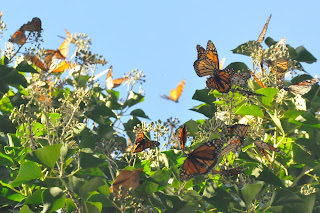Fall 2021 - Giving Thanks for Monarchs (and Scrub Jays)
Giving Thanks for Monarchs (and Scrub Jays)
After the devastating news last year that there were no monarch butterflies at the Pacific Grove Monarch Sanctuary, we were overjoyed to see these iconic insects make a comeback in 2021!
My husband, Brian, and I had to witness this miracle for ourselves, so took a drive down to the sanctuary over Thanksgiving weekend. Pacific Grove is truly our 'happy place,' where we were married years ago and enjoyed many long weekends in the ensuing years. So on our way into town we stopped by Bookworks for some coffee and pumpkin bread, savoring it at an outdoor table and noting, with joy, the occasional monarch flitting past.
Nearby a scrub jay perched with an acorn in its beak, casting a wary eye in our direction before burying its treasure in some nearby ivy. We had just recently learned, from Doug Tallamy's "The Nature of Oaks" that jays may carry an acorn as far as a mile before burying it. Furthermore, just one single jay can bury about 4,000 acorns in a season. Even with all this effort, and their strong memories, they still forget where 3/4 of the acorns are buried, and in this way a single jay can plant as many as 3,500 oaks annually.
It struck me as funny to hear that if the jay believes that it was watched while hiding its acorn, it will sneak back later and find another hiding place for it. On this particular day, I think that is just what happened, based on the way this one was looking at me (note last frame).
We finished our coffee, hopped in the car and headed to the Monarch Sanctuary. It is free, and you can learn more about it here: Monarch Viewing — Pacific Grove Museum of Natural History (pgmuseum.org)
Walking along the path, there was a festive air, though everyone was respecting the monarchs need for quiet. Here and there people had set up tripods with large cameras to capture the best images. Nearby a docent was explaining that the monarchs relied on nectar plants in and around the sanctuary to maintain their strength during the winter months. Then, when they leave the sanctuary in February and March, they would need to find nectar all along their inland journey, so people living on the coast should plant nectar plants, preferably native ones. A good list can be found here: 19-046_01_MonarchNectarPlants_California_web-4pg.pdf (xerces.org)
As they fly further inland, the female monarchs start to seek out native milkweed so they can lay their eggs. In ideal circumstances, when milkweed is plentiful, the female would lay just one or two eggs per plant, as a single monarch caterpillar can eat a whole plant!
The docent also shared that a recent count put the current number of monarchs at that sanctuary at 13,000. And although the guests in the sanctuary were keeping quiet to help the monarchs rest and conserve energy, there was a sense of shared celebration around the resurgence of this iconic butterfly.
Monarchs flutter in the sun at the
Pacific Grove Monarch Sanctuary

Monarch caterpillar at Rinconada Community
Garden (Palo Alto, California)
Monarch chrysalis at Rinconada
Community Garden









Comments
Post a Comment
Please Leave a Reply